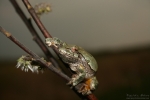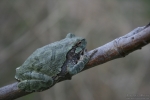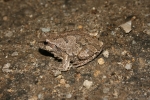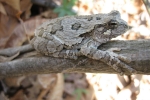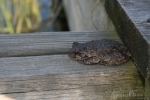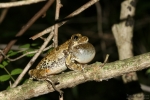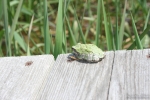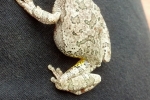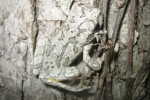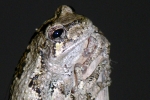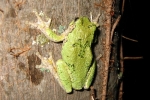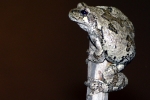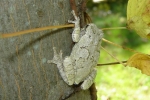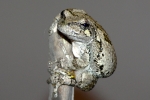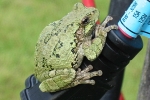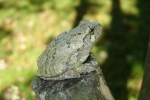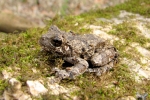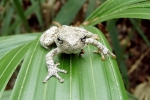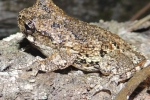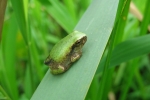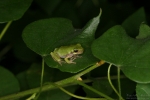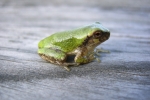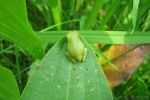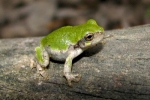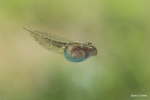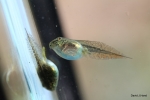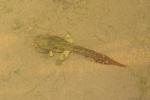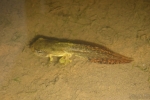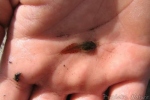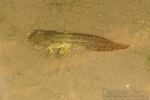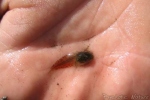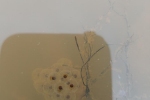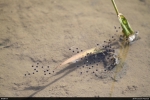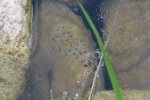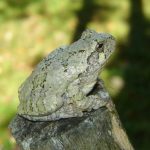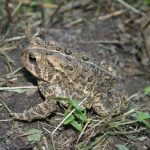Gray Treefrog
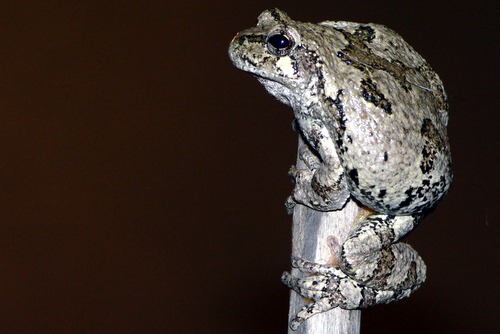
Scientific Name: Hyla versicolor
Size: 1.6-2 inches (4-5 cm) in length
Status: Abundant
PAHERP Resource: Frogs in my Swimming Pool
Habitat:
Deciduous woodlands near ponds, pools or ditches. Mating Season: Lower vegetation of old fields, meadows, ecotonal habitats.
Description:
Moderate-sized species. Light gray to dark to greenish gray with a dark central blotch that has projecting branches that may be wavy or straight. These branches may often be broken. The top of the head and eyelids have dark spots. The dorsal surface of the legs has dark crossbars. The sides of the head are darker than the top with a white, black bordered spot just below the eyes. The ventral chest and belly area are cream-colored, and the groin, underside, and back of the thighs having an orange or yellow color with black reticulated lines.
- The dorsal background color is light gray to dark to greenish gray with a dark central blotch that has projecting branches that may be wavy or straight. These branches may often be broken.
- The top of the head and eyelids have dark spots.
- The dorsal surface of the legs has dark crossbars.
- The sides of the head are darker than the top with a white, black bordered spot just below the eyes.
- The ventral chest and belly area are cream-colored, and the groin, underside, and back of the thighs having an orange or yellow color with black reticulated lines.
- The body is moderately sized and flexible.
- The head is broad with a blunt snout.
- The eyes are large and positioned on the sides of the head.
- The tympana is small and inconspicuous.
- The dorsal skin is covered with small warts.
- The ventral skin is granular.
- The toe pads are twice the width of the toes.
- The hind toes are webbed.
- The legs and toes are long.
- Moderate-sized. Average 2-4 cm
- The dorsum and sides are greenish in color with golden flecks.
- The belly is cream colored.
- The eyes are located on the sides of the head.
- The tail is reddish is color.
- The tail crest is somewhat translucent with large dark spots.


- There are no physical distinctions between the Eastern Gray Treefrog and the Cope's Gray Treefrog.
- The calls are the best way to determine the difference in the two species.
May be Confused With:
References:
- Hulse, C. and McCoy C. J. and Ellen Censky ,1998. Amphibians and Reptiles of Pennsylvania and the Northeast. 144-148pp.
- Wayne Fidler
- Jeff Hankey
- Bob Hamilton
- Chris Harrison
- Matthew Jennette
- Don Becker
- David J. Hand
Heads up!
Please contribute your observation of this and other herps to the Pennsylvania Amphibian and Reptile Survey. Your help is needed.
